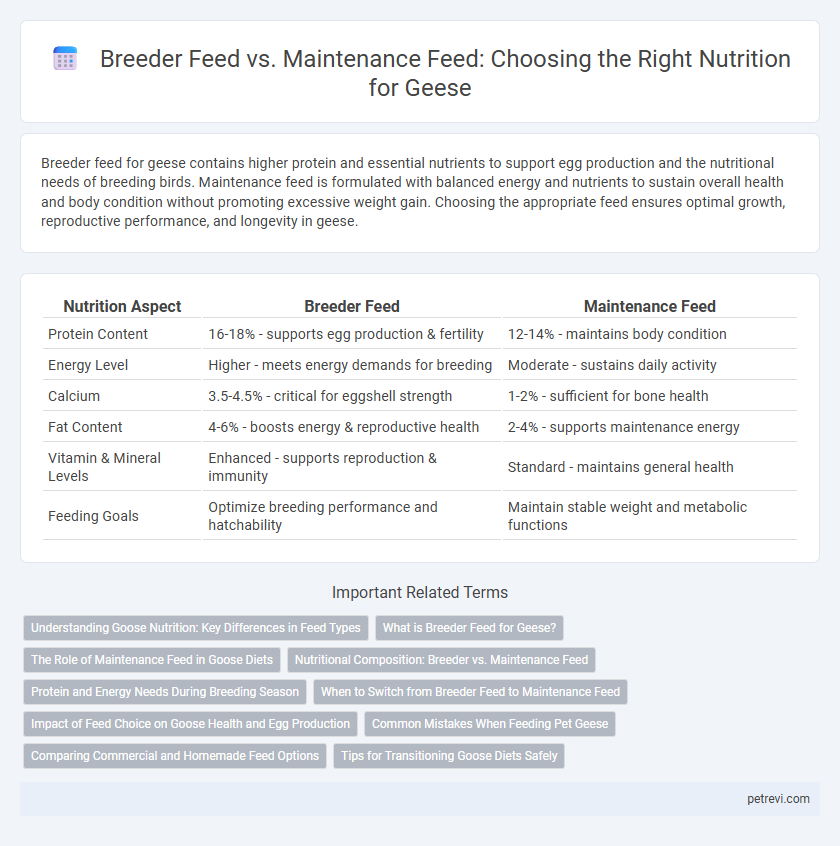Breeder feed for geese contains higher protein and essential nutrients to support egg production and the nutritional needs of breeding birds. Maintenance feed is formulated with balanced energy and nutrients to sustain overall health and body condition without promoting excessive weight gain. Choosing the appropriate feed ensures optimal growth, reproductive performance, and longevity in geese.
Table of Comparison
| Nutrition Aspect | Breeder Feed | Maintenance Feed |
|---|---|---|
| Protein Content | 16-18% - supports egg production & fertility | 12-14% - maintains body condition |
| Energy Level | Higher - meets energy demands for breeding | Moderate - sustains daily activity |
| Calcium | 3.5-4.5% - critical for eggshell strength | 1-2% - sufficient for bone health |
| Fat Content | 4-6% - boosts energy & reproductive health | 2-4% - supports maintenance energy |
| Vitamin & Mineral Levels | Enhanced - supports reproduction & immunity | Standard - maintains general health |
| Feeding Goals | Optimize breeding performance and hatchability | Maintain stable weight and metabolic functions |
Understanding Goose Nutrition: Key Differences in Feed Types
Breeder feed for geese contains higher protein and energy levels, essential for egg production and supporting gosling growth, while maintenance feed focuses on balanced nutrients to sustain adult health and activity without excess calories. Key differences in mineral and vitamin content cater to reproductive needs in breeder feed versus general health requirements in maintenance feed. Proper selection between breeder and maintenance feed ensures optimal nutrition, enhancing reproductive performance and overall flock vitality.
What is Breeder Feed for Geese?
Breeder feed for geese is specially formulated to support reproductive health and egg production, containing higher levels of protein, calcium, and essential vitamins compared to maintenance feed. This feed type enhances fertility, shell quality, and overall hatchability by meeting the increased nutritional demands during the breeding cycle. Proper breeder feed ensures optimal gosling development and successful breeding outcomes in commercial and hobby goose flocks.
The Role of Maintenance Feed in Goose Diets
Maintenance feed plays a crucial role in sustaining the health and basic functions of geese by providing balanced nutrients at adequate levels to meet their daily energy and metabolic requirements. Unlike breeder feed, which is formulated with higher protein and vitamins to support egg production and growth, maintenance feed focuses on preserving body condition without excessive weight gain. Proper use of maintenance feed ensures optimal feather quality, immune function, and overall vitality in adult geese during non-breeding periods.
Nutritional Composition: Breeder vs. Maintenance Feed
Breeder feed for geese is formulated with higher protein levels, typically around 16-18%, and increased calcium content to support egg production and reproductive health, while maintenance feed generally contains 12-14% protein, focusing on energy balance for daily upkeep. The breeder diet also includes elevated vitamins and minerals, such as vitamin E and phosphorus, essential for optimal fertility and hatchability. Maintenance feed prioritizes fiber and energy sources like grains to sustain body condition without promoting excessive weight gain.
Protein and Energy Needs During Breeding Season
Goose breeders require feed formulations with higher protein levels, typically 16-18%, to support egg production and reproductive health, while maintenance feed usually contains 12-14% protein to sustain normal body functions. Energy content in breeder feed is also elevated, often around 2800-3000 kcal/kg, to meet the increased metabolic demands during the breeding season, whereas maintenance feed provides moderate energy levels near 2600 kcal/kg. Optimizing protein and energy intake during breeding enhances fertility, hatchability, and overall flock performance.
When to Switch from Breeder Feed to Maintenance Feed
Switching from breeder feed to maintenance feed for geese should occur immediately after the breeding season ends to prevent excess nutrient intake and potential obesity. Breeder feed contains higher protein and energy levels tailored for egg production and reproduction, while maintenance feed provides balanced nutrition to sustain health without promoting unwanted weight gain. Monitoring the geese's reproductive cycle and body condition ensures the transition supports optimal growth and longevity.
Impact of Feed Choice on Goose Health and Egg Production
Breeder feed, rich in protein, vitamins, and minerals, significantly enhances goose health and egg production by supporting reproductive functions and boosting immune response. Maintenance feed, lower in nutrient density, is suitable for adult geese not in laying phase but may lead to reduced egg yield and poorer overall condition if used during breeding. Optimal feed choice directly impacts nutrient absorption, metabolic efficiency, and longevity, making breeder feed essential during laying periods for maximizing productivity.
Common Mistakes When Feeding Pet Geese
Using breeder feed instead of maintenance feed for pet geese often leads to excessive protein and energy intake, causing obesity and metabolic disorders. Many owners mistakenly apply breeder feed year-round, ignoring seasonal nutritional needs that maintenance feed addresses with balanced protein and minerals. Overfeeding rich breeder diets can result in poor feather quality and reproductive issues in non-breeding geese.
Comparing Commercial and Homemade Feed Options
Breeder feed for geese contains higher protein levels, typically 16-18%, and essential nutrients like calcium and phosphorus to support egg production and gosling growth, while maintenance feed is lower in protein, around 12-14%, designed to sustain adult geese health without promoting excessive weight gain. Commercial feeds provide balanced formulas with consistent nutrient profiles validated by feed trials, ensuring reliability but often costing more than homemade blends, which require careful ingredient selection such as grains, legumes, and mineral supplements to achieve similar nutritional adequacy. Homemade feed offers flexibility and cost savings but demands precise formulation to avoid deficiencies or imbalances compared to standardized commercial breeder and maintenance feed options.
Tips for Transitioning Goose Diets Safely
Gradually introduce breeder feed to goslings by mixing it with their maintenance feed over 7 to 10 days to prevent digestive upset and ensure proper nutrient absorption. Monitor their droppings and behavior closely during the transition to detect any signs of intolerance or imbalance. Provide constant access to clean water and consider supplementing with probiotics to support gut health during dietary changes.
Breeder Feed vs Maintenance Feed for Goose Nutrition Infographic

 petrevi.com
petrevi.com